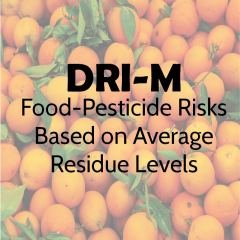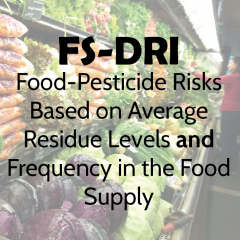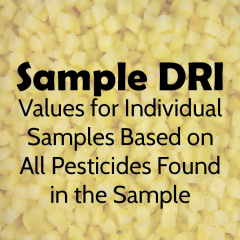
For a given pesticide-food combination, the DRI-Mean (DRI-M) is calculated based on the “mean of the positives” residue level.
Process
From all samples of a given food tested in a given year, the DRI system selects those samples with a quantified residue of each pesticide. Then, across just these positive samples, the system calculates the mean (average) residue level by food-pesticide combination, and uses that level in computing the food-pesticide’s DRI-M value.
Accordingly, the DRI-M represents the most accurate estimate of the average risks arising from consumption of servings of a food known to contain the residues of the pesticide in question.
Limitations
But the DRI-M value for a given food-pesticide combination provides no information or insight into how frequently a serving of a given food is likely to contain residues of the pesticide in question.
A DRI-M value of 0.5 for a food-pesticide combination might be based on just three positive samples out of 600 samples tested, or 250 positives out of 600. Obviously, more eating episodes will arise from a food-pesticide combination for which 250 out of 600 samples are positive, in contrast to to a food-pesticide combination with just 3 positives.
The frequency of consumption is a function of the percent of samples that are found to contain residues of the pesticide in question.
The Food-Supply DRI (FS-DRI) takes this key factor into account.
Pesticide dietary risk is a function of how frequently a person is exposed to pesticides in their daily diet, as well as how risky each exposure is.
The risk level arising from the presence of a given residue is determined by its level in food, the pesticide’s toxicity, and how much of the food was consumed.
The Food-Supply DRI (FS-DRI) takes into account both the “mean of the positives” residue level, and the frequency with which such residues are likely to be detected in the supply of a given food.
Process
The FS-DRI is simply the DRI-M value multiplied by the percent of samples containing a residue of the pesticide in question.
DRI-M values for any food-pesticide combination will exceed FS-DRI values, unless 100% of samples tested contained the residue in question.
In the DRI-M example example discusses above focused on how the number of positives impacts DRI-M levels, the big difference in the percent positive parameter (3 out of 600, versus 250 out of 600) would have a big impact on FS-DRI scores:
Case #1 DRI-M: 3 positive samples out of 600, DRI-M = 0.5.
Case #2 DRI-M: 250 positive samples out of 600, DRI-M = 0.5
Case #1 FS-DRI: (DRI-M = 0.5) x (3/600) = FS-DRI = 0.0025
Case #2 FS-DRI: (DRI-M = 0.5) x (250/600) = FS-DRI = 0.21
The FS-DRI value for a given food-pesticide combination provides the best, average estimate of risks arising from chronic, or frequent exposures to a pesticide over a long period of time.
Limitations
The FS-DRI underestimates the daily risks associated with ingestion of a given residue. Sometimes consumers purchase fresh products or grain-based products in bulk. In such a household, individuals will be exposed consistently to the residues in the purchased food, rather than to a random sampling of the food.
Hence, for some people, FS-DRI values will be biased downward, and for others, exaggerated.
Like the DRI-M, the FS-DRI provides little insight into the distribution of exposures, since it is driven by the “mean of the positives” residue level.
DRI values for the pesticides found in an individual sample of food are straightforward and easier to interpret relative to regulatory exposure thresholds. Each individual sample of a given food is made up of about 5 pounds of product selected at random from the food supply. So, each individual sample is actually representative of MILLIONS of servings of that food at dinner tables and school cafeterias across the country.
Process
For each pesticide analyte found in an individual sample of food, the DRI is simply the residue level divided by the maximum amount of the pesticide that can be in the food, without exceeding the EPA’s “level of concern.”
Assessing the distribution of individual-sample DRI values for a given food-year combination is the best way to gain perspective on the risks arising from consumption of foods with the highest DRI values, compared to foods with the lowest.
For most food-pesticide combinations, this distribution is highly skewed, with a small number and modest percent of samples falling in the “significant” risk zone along the dietary risk continuum, and the majority of samples falling in the two lower-risk zones. (See <“Interpreting DRI Values”> for an explanation of the DRI risk continuum).
Tracking down where and how the high-risk samples were grown is an important first step in identifying why farmers applied pesticides leading to relatively high risks, when most growers producing the same crop in the same year did not have to use high-risk pesticides in ways resulting in residues landing within the significant risk zone along the dietary risk continuum.
Limitations
Most US PDP samples come from warehouses where multiple sources of various fresh fruits and vegetables are accessible. The typical US PDP sample contains 5 pounds of produce, with individual pieces of fruit or vegetables drawn from more than one supplier.
The 5 pounds of produce is then blended together into a composite sample, from which the sample for testing is extracted. Accordingly, the residues found in the composite sample might have come from produce grown on different farms in different areas.
In the case of other food forms, like raisins and frozen mixed vegetables, the residues found in a composite sample also might have come from many different farms.
This limitation is not a significant problem in assessing DRI values and relative risk levels for individual samples, but does raise caution in interpreting one DRI system data point — the average number of residues found in an individual sample of food.
A sample containing 20 residues does not necessarily mean 20 different pesticides were sprayed on the field from which the crop was harvested.
See more:
- Introduction to Pesticide Dietary Risks
- The DRI Analytical System– Intro, how to use the Lookup Tools, and Applications of the DRI
- Access DRI Data via our Interactive DRI Lookup Tools
- Understand DRI Results and How to Interpret Them
- See DRI Technical Details such as data sources and methodology
- Scientific research on pesticide dietary risks at the Heartland Study


